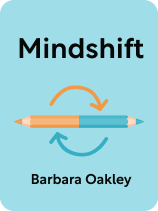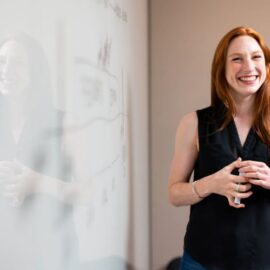

This article is an excerpt from the Shortform book guide to "Mindshift" by Barbara Oakley. Shortform has the world's best summaries and analyses of books you should be reading.
Like this article? Sign up for a free trial here.
Are you contemplating a career change? Are you afraid that it might be too late?
Whether you’re unhappy at work, interested in another field, or worried that your job is in danger of becoming obsolete, it’s never too late to make a career change. Barbara Oakley asserts that, whatever your age or occupation, you can have a mindshift.
Keep reading for our Mindshift book overview.
Mindshift Book Overview
Having a mindshift means expanding your skill set—and, consequently, your opportunities—through transformative learning. In her Mindshift book, Oakley writes that it’s possible to overcome perceived barriers (such as age, imposter syndrome, or a lack of money) and gain new skills so you can reinvent yourself.
Oakley is proof that it’s possible to make a big change and flourish despite presumed weaknesses. She says that growing up, she believed she wasn’t good at math or science, so she avoided those subjects in college and got a degree in languages. After graduating, she worked for the US Army as a signal officer, which required her to use complicated communications equipment; this job ignited in her such a strong interest in math and science that she later earned a second degree (and eventually a Ph.D.) in Electrical Engineering. She is currently a Professor of Engineering at Oakland University.
Oakley’s experience led her to write books such as A Mind for Numbers, which aims to help the numbers-averse get more comfortable with math, and Learning How to Learn, which outlines study tactics to help readers master any subject. Oakley also has a number of popular online courses with millions of enrollees on Coursera. Mindshift was published in 2017 and is also the title of one of her online courses.
The Importance of Mindshifts
Mindshifts are important for two reasons. First, Oakley asserts that they allow us to reach our full potential. Often, we’re forced to choose a career path at an early age, when we still don’t have a real sense of who we are or what we want to do. Having a mindshift allows us to diverge from a path we set as teenagers and become more than we thought we could be.
Second, Oakley argues that mindshifts allow us to enhance or gain skills so we can keep up with a fast-changing world. With technology developing at breakneck speed, our roles at work are constantly evolving and requiring us to adapt. Mindshifts give us more versatility and enable us to provide more value to employers, future-proofing our careers. For example, as more companies use chatbots and voicebots to field customer inquiries, human customer service agents who are worried about job security would benefit from having a mindshift.
Oakley cites Singapore as a prime example of a country that recognizes the importance of giving its workforce career flexibility. Under the SkillsFuture program, the Singapore government gives a S$500 credit (roughly US$375 as of May 2023) to citizens who are 25 years old and above, with the amount going toward any training they wish to pursue. This enables the workforce to enhance existing skills to help them move forward in their careers or acquire new skills that will prepare them for a new field.
However, not everyone lives in a place with readily available support for their professional and personal development. If you don’t have access to government- or employer-subsidized training, you can take charge of your own learning. In the next section, we’ll discuss Oakley’s tips for having a mindshift so you can broaden your options.
How to Have a Mindshift
Oakley’s three main tips for having a mindshift change your perspective, determine what you want to do next, and learn how to learn. We’ll discuss each in detail.
Change Your Perspective
Oakley says that to have a mindshift, you first need to adjust your mindset. In particular, you should realize the value of your experience and be humble.
Oakley writes that shifting to something new may seem intimidating because you feel like others in your desired field have a head start, but she argues that starting later than your peers doesn’t necessarily put you at a disadvantage. In fact, she asserts that your experience in one field gives you unique, transferable skills that you can use in unexpected ways in another field. She gives the example of a Juilliard-trained musician who later became a doctor; his musically trained ear gave him the unique ability to detect irregular heart sounds.
Further, Oakley says that your experiences don’t even have to be related to your career and can instead come from your hobbies. For example, if you’ve built a respectable following by making cooking videos on your personal TikTok account, you might parlay this experience into helping your employer generate more engaging Instagram reels on the company account.
While it’s important to know the value you bring to a new field, it’s equally important to embrace being a beginner. It may be difficult to find yourself back at square one, especially if you’re already highly accomplished in another field, but acknowledging your newbie status can make you more open to learning new things because you accept that you don’t know it all.
Determine What’s Next
Once you’ve reframed your thinking and opened your mind to the possibility of learning new skills, reflect on your desired career path.
There are two ways to go about making a career change. The first is to shift to another field entirely, which requires persistence and a healthy dose of the humility Oakley prescribes. You might need to immerse yourself in an environment where you’ll get plenty of guidance and exposure to your target field. For example, if you want to become a pastry chef, you might leave a cushy office job so you can work as a server at a restaurant and closely observe a patissier in action.
The second way to make a career change is to shift to something that’s still within your current field. Oakley says this is an especially viable option for those who’ve already spent years of study and practice in a demanding field such as medicine or law—you can explore another specialization instead of starting from scratch and putting in more years of exhaustive study. For example, if you’re an accountant, you can go from being an auditor who inspects companies to a financial consultant who helps individuals prepare for retirement.
Learn How to Learn
Once you determine what you want to learn, come up with a plan to learn it. The kind of learning you did in school, which may have focused on rote memorization, may not be the best route to achieving your goals. Oakley says that to learn more effectively, you should use both modes of your brain—focused mode and diffuse mode.
Focused mode is when you concentrate fully on the material you’re learning. Oakley recommends “chunking” to help you master challenging concepts and skills. On the other hand, diffuse mode is when you allow your brain to relax. Research suggests that this mode is a necessary part of learning, giving your brain time to process what you’ve learned, store it, and connect it with other information, leading to new insights.
Overcoming Perceived Barriers
In addition to her general tips for having a mindshift, Oakley has specific advice for overcoming common perceived barriers to learning new skills: being a slow learner, thinking you’re too old, feeling like an imposter, and not having enough time or money.
Barrier #1: Being a Slow Learner
This barrier can manifest in two ways: You might grasp concepts more slowly than your peers, or you might believe you’re a slow learner because your way of learning differs from schools’ traditional methods of teaching.
If you’re a slow learner who takes more time to understand concepts compared to your peers, the following tips can help you manage:
1. Be prepared. Find out what you’ll be learning in class in advance so you can get familiar with the material and get a headstart on understanding it.
2. Use idle time to learn. Keep your books or notes with you at all times so you can go through them during pockets of free time, like while you’re waiting in line at the coffee shop or on your train ride home from work.
3. Improve your memory. Memorization is a key component of understanding and applying ideas—being able to retain several concepts in your head enables you to solve problems more quickly and connect ideas in creative ways. Oakley thus recommends improving your memory with memory practice.
Barrier #2: Advanced Age
As we age, our brains deteriorate, with neurons (brain cells) naturally dying off and synapses (the connections between neurons that lead to memory formation) decreasing. This decrease in neurons and synapses makes it harder for us to remember things and learn new information. However, Oakley says there are research-backed ways to help generate new neurons and synapses to facilitate learning, no matter how old you are.
In particular, Oakley recommends two methods:
1. Exercise. While it isn’t a panacea for brain aging, exercise leads to the production of a powerful protein called brain-derived neurotrophic factor (BDNF). Oakley explains that BDNF protects neurons and synapses (preventing them from deteriorating) and boosts our cognitive functions, including our ability to retain long-term memories.
2. Give your mind a regular workout too. Oakley writes that when you challenge your brain by doing or learning something new each day, you encourage neurons to grow and fortify their connections to one another. You can challenge your brain by taking up a hobby, learning a new language, or even performing a simple task like using your non-dominant hand when you brush your teeth.
Barrier #3: Imposter Syndrome
The third barrier to learning new skills is imposter syndrome—doubting your abilities, feeling like a fraud, and attributing your accomplishments to factors other than your skills and hard work. Imposter syndrome makes you anxious about taking risks and trying something new.
Oakley says that those who feel imposter syndrome tend to be high achievers or women, many of whom are brought up to think that being modest about their accomplishments is a desirable trait.
Barrier #4: Lack of Time or Money
Going back to school to earn a degree (or another one) can open new doors, but for many, the time and financial commitment may be prohibitive.
Oakley has the following tips to get around this obstacle:
1. Get a mentor. According to Oakley, mentors can bring value to both your work and your personal life. You can benefit from having two mentors: One to serve as a cheerleader who encourages you to keep going, and one to give you constructive feedback and keep you accountable.
2. Sign up for a MOOC. MOOCs, or massive online open courses, are classes you can access through the Internet. Oakley writes that there’s a MOOC for virtually anything you want to learn, and some are even offered by prestigious universities.

———End of Preview———
Like what you just read? Read the rest of the world's best book summary and analysis of Barbara Oakley's "Mindshift" at Shortform.
Here's what you'll find in our full Mindshift summary:
- That it's never too late to make a career change
- How to overcome the mental barriers that hold you back
- Why career shifts are essential in the fast-changing world






